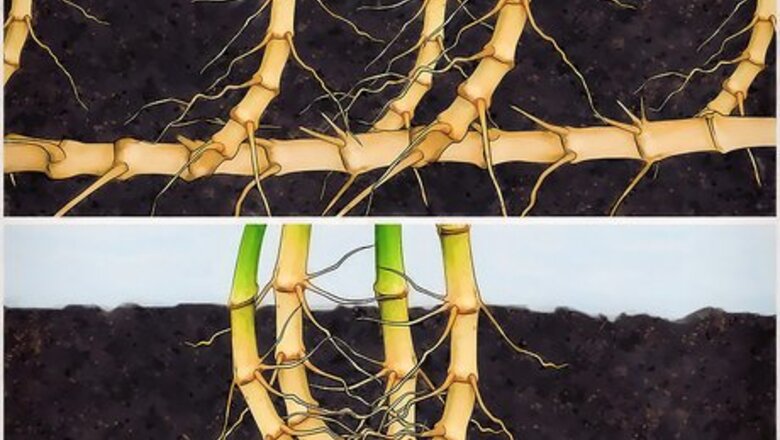
views
Cultivating a Healthy Environment

Differentiate running and clumping bamboo. These are the two main varieties of bamboo. Many of the procedures you'll use to care for your running or clumping plants will be interchangeable among these two plants, but there are some differences you may want to take into account for aesthetic purposes. Running bamboo has thick canes spaced at regular intervals, much like the stereotypical image of bamboo. Clumping bamboo has thinner canes, a bush-like appearance, and its canes appear to sprout from the same, or nearly the same, location in the ground. Running bamboo makes for a better screen when planted. Unlike clumping bamboo, which has drooping top segments and a narrow base, runners naturally form a screen with straight, vertical stalks.
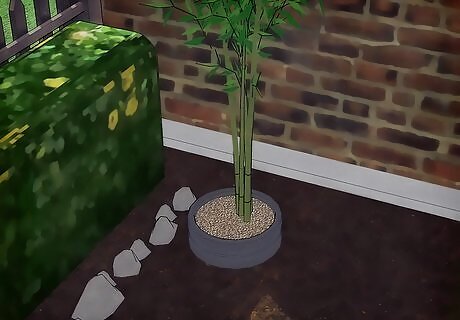
Provide bright, indirect sunlight. If you have already planted your bamboo in an area that receives a lot of direct sunlight, you may want to string up a cloth between bean poles or stakes to offer some shade to the plants. Bamboo naturally grows in areas with partial shade, and giving this to your plants will encourage healthy growth.
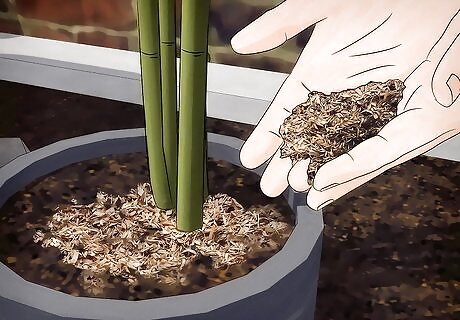
Add mulch to the soil around your bamboo. Mulch will help protect the roots of your bamboo from sudden changes in weather, like cold snaps. It will also soak up water for the plant during dry periods. Additionally, it will deter weeds from encroaching on your bamboo plants. Spread your mulch carefully around young stalks and newly emerging bamboo. Too much mulch can damage the plant or make it difficult to grow. You can spread mulch freely around the stalks of heartier, more established plants. Leave about an inch (2.5 cm) of free space around your stalks so the roots receive enough airflow.
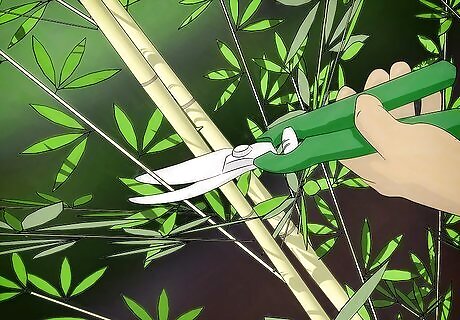
Trim your shoots. You won't likely need to trim your bamboo until it has grown for a few years and filled in with leaves. Trimming will help your other plants receive more adequate sunlight. This will also remove growths that are unsightly or less healthy, encouraging the overall health and appearance of your plant. When trimming, you should prioritize branches that look dead, sick, or weak. Most bamboo can be pruned without fear of harming the plant, so you should trim freely to achieve the look you desire in your bamboo.
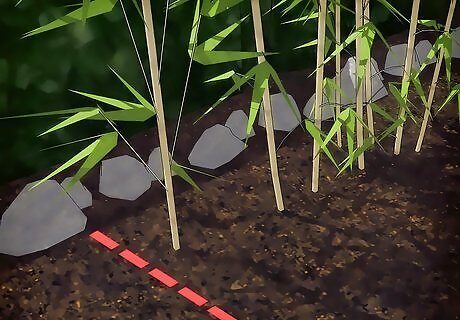
Control the root growth of running bamboo. The roots of your running bamboo can easily grow out of control if you're not careful. If your bamboo is growing in an open area, this might not be a problem, however you can easily prevent the roots of your running bamboo from becoming invasive by trimming the roots. Build an underground barrier 30 inches (76.2 cm) deep and 2.4 inches (6.1 cm) thick around your bamboo to prevent unwanted root spreading. Set a boundary for the roots of your bamboo plant and then dig a narrow trench on that boundary about 1 foot (.3 m) deep. Trim or sever any roots that you find in this trench, and check it regularly for new root growths. Trimming the roots of your running bamboo will not harm the plant. These roots can usually be found roughly 5 inches (12.7 cm) deep in the soil.
Nurturing Your Bamboo

Water your bamboo according to season. The most active season for bamboo growth is spring, so you should begin watering in late winter or early spring. Watering should be done on a weekly basis, and you should continue this watering schedule throughout the summer months.
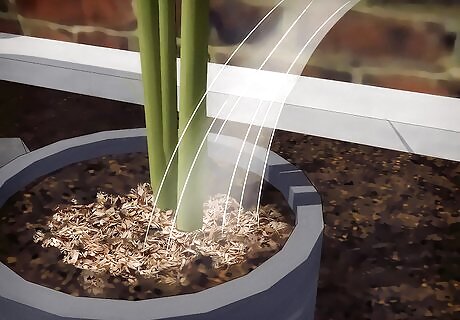
Water with moderation. If you are growing your bamboo in loamy soil that drains well, you won't likely have issues with watering. Even so, the best environment for your bamboo to grow in will be moist, without being saturated or dry. You'll be able to tell if your bamboo is not receiving enough water by the curl of its leaves. If you notice leaf curl, continue your watering schedule, adding water in small increments until the leaves relax. Some types of bamboo will also suffer from leaf curl in overly sunny environments. If you add water to your routine and notice no difference in the leaf curl, this could be an indication your plants are getting too much sun.

Fertilize your bamboo. Fertilizing your bamboo will guarantee it has the nutrients it needs to grow healthy and strong. Fertilizing is especially important if your soil is low in phosphorous, nitrogen, or potassium. These three substances are vital for healthy, strong bamboo. You should add high nitrogen fertilizer or compost to the soil surrounding your bamboo in early spring and summer. This will ensure your plants have the nutrients needed for their active growing seasons. You might want to consider using grass/lawn fertilizer for your bamboo plants. This is widely available at home and gardening stores, and will provide your bamboo with the food it needs.
Troubleshooting Bamboo Problems

Transplant healthy cuttings from your bamboo plants. If part of your bamboo plant is struggling, cut off the healthy parts of the culm and transplant them so that they can thrive. Fill a pot with potting mix and then seal the ridges of your bamboo cuttings by dipping them in melted wax. This will keep them from drying out or rotting. Immerse the cuttings in rooting hormone and then plant the cuttings in the pot. When cutting the healthy parts of your bamboo, try to include two or three leaf-nodes per section. These nodes can be found by looking for a thickening of the stalk. In some cases, these will have offshoots. Remove leaves from the cuttings before transplanting. Cover the cuttings with a plastic bag, keep the soil moist, and put the pot in a warm location.

Remedy brown tipped leaves. One of the most common causes of this is fluoride burn, which can especially be a problem if you live in an urban environment. The fluoride added to your water supply can cause the tips of your bamboo leaves to turn brown, though this can also be an indication that the air or soil is too dry for your plants. Use distilled water or collected rainwater for your plants for cases of fluoride burn. You might leave a bucket or kiddie pool outside to catch rainwater, or you could build a rainwater collection system.
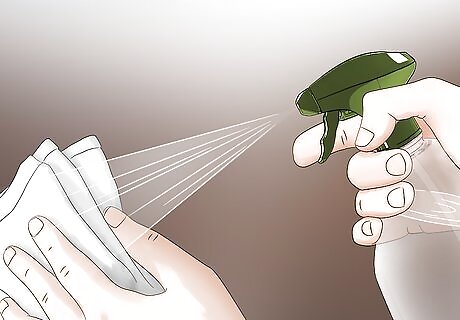
Use a damp cloth to remove dust from the bamboo leaves. If the leaves on your bamboo plants have even a thin layer of dust on them, your plants may struggle to thrive. Plants get their fuel through photosynthesis, and a dust barrier between the leaves and the sunlight may hinder that process. Wet a clean cloth with water and carefully wipe down the leaves if you notice any dust accumulation. You can also eliminate this problem by misting your bamboo or dusting the leaves with art brushes.



















Comments
0 comment